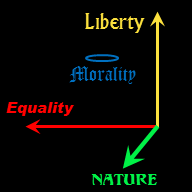The Three Economic Pillars

An economy can be broken down into three major components: Land, Labor and Capital. Economists use the term “Land” in a special sense: that which was not created by people. “Land” includes the inherent value of real estate before development adds value; that is, land value before clearing, road building and the placement of buildings. “Land” also includes mineral rights; right-of-ways for railroads, gas pipelines, electric lines, phone lines and cable television; broadcast rights for radio and television; fishing rights; and so forth. Labor is simply value produced by work. Capital is stored wealth that is used to create new wealth: factories, roads, office buildings, trucks, farm machinery and so forth. I will try to capitalize the terms Land, Labor and Capital when I mean specialized economic definitions vs. common-sense usages.
Both capitalists and landlords make money by having money. The more you have to invest, the more income you can receive for the same level of risk. Since rich people can theoretically invest a greater share of their income, they can over time create a greater income stream, thus widening the gap between rich and poor. For this reason, progressives throughout history have called for more of the total share of income to go to Labor vs. the owners of “Land” and Capital, and correctly so.
Accumulation of capital and stewardship of natural resources are two major values produced by the wealthy. Persecute the wealthy and you end up with shortages of capital and often experience environmental destruction. Increase the supply of capital and land/natural resources and you reduce the income of the wealthy while improving the general welfare.
And here is good news for freedom-lovers: free market capitalism over time increases the quantity of capital. As capital increases, the rate of return on investment decreases; a greater share of the national income goes to laborers. This fact was noted and documented by Adam Smith! When I first read from “The Wealth of Nations” I nearly fell out of my chair when Smith talked about reducing profits and increasing wages through free markets. Adam Smith was an egalitarian! This was the opposite of what I was taught in high school.
So why aren’t the mature capitalist societies more egalitarian? Part of the answer is that they are more egalitarian than the feudal societies they once were. But the other part of the answer is that trillions of dollars have gone into government programs to halt this process of wealth leveling. In particular, the United States government has sunk trillions of dollars into programs which subsidize the owners of wealth much in the same way it spends billions of dollars to subsidize the owners of farms.
And to add insult to injury, income earned through wealth ownership is taxed at a lower rate than income earned through hard work.


